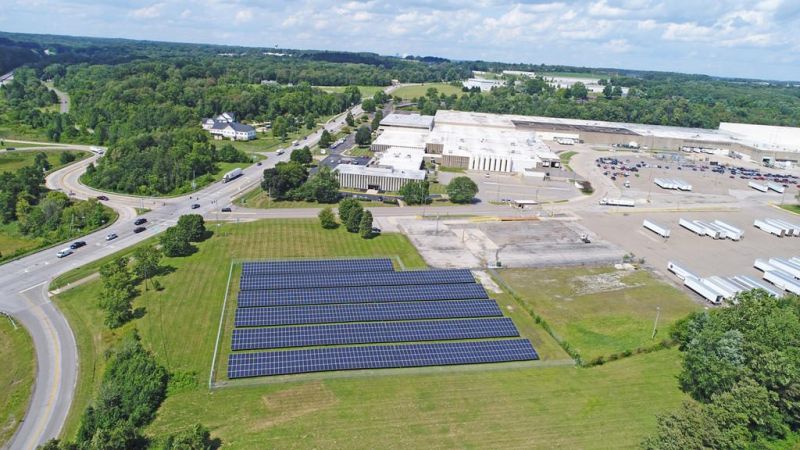Choosing a renewable energy company for home and office
Are all those letters that come in the mail about making an energy choice confusing? Do they seem to all come from only one or two companies? Are they written to make it sound like there is some sort of urgent deadline for a response?
Frederick Michel, the president of the Wayne County Sustainable Energy Network, offered information to help clarify the confusion and steer residents who want to make a switch toward the most cost-effective options. Michel is a professor at Ohio State University Wooster.
Michel said those served by AEP and First Energy have the option to choose the company that generates their electricity — giving consumers the opportunity to opt into a source that provides 100% renewable energy.
“Ohio disconnected the sale of energy distribution and transmission from energy supply,” Michel said. “For residential customers, depending on where you live in Wayne County, you will pay for transmission and distribution to either AEP, First Energy or Holmes-Wayne Rural Electric Cooperative. The distribution and transmission company cannot be chosen, and their charges will appear on your bill as transmission and distribution fees. They are usually proportional to the amount of energy used. There is also a fixed fee on your bill that these companies charge.”
What customers served by AEP and First Energy can do is choose their energy supplier. This allows households with options to choose renewable energy. The Public Utilities Commission of Ohio provides an apples-to-apples comparison tool at www.energychoice.ohio.gov to clarify the array of choices. The tool lists prices, contract terms and other plan differences. Holmes-Wayne and Orrville customers cannot choose their provider.
According to Michel and based on prices as of Nov. 1, “The average electric utility retail price in Ohio is currently $0.12/kWh, which represents a 16% increase from one year ago. Since most of Ohio’s electricity is generated from nonrenewable sources, this increase represents increases in the cost of those sources.
“Renewable electricity, on the other hand, has dropped significantly in price over the past two years. Right now I would recommend choosing 100% renewable energy at the lowest fixed price. The best price currently available for AEP customers is $0.077/kWh fixed rate for 100% renewable energy for six months from Inspire Energy Holdings.
“AEP Energy (not AEP but a separate subsidiary with the same name) offers 100% renewable energy for $0.099/kWh for a longer 36-month term. By comparison, the best fixed 36-month rate for electricity made from fossil fuels is $0.082/kWh. All of these prices are well below the average Ohio and U.S. electric utility retail prices.”
When considering options to make a switch to renewable energy, Michel said the most important consideration is the percent of renewable-energy content in the energy source. The second is the price, and the third is price stability.
According to Michel, the sources of electricity for AEP are 42% coal; 28% natural gas; 8% nuclear; 20% hydro, solar and wind; and 2% other. First Energy generates 99% of its energy from coal. Holmes-Wayne Rural Electric Cooperative’s electricity is generated mostly from coal and the rest from natural gas. The Orrville Utility generates 25% of its electricity from coal at the city’s power plant and 1% from solar. The rest is purchased from other sources. These include 30% of the total from natural gas, 21% from hydro, 14% from coal, 2% from wind and 1% from solar.
Although local energy customers may receive lots of mailings from just one or two of the alternative options, Michel said there are 76 different energy providers AEP customers may choose from. First Energy households have 68 options.
Michel said if a customer already has solar and uses net metering, the suppliers do not have to follow the same rules. In this case one should seek additional information.
Currently, Michel recommends choosing a fixed rate. “Market prices have not changed much over the last few years. However, they are likely to head up as we see more volatility (in a wide variety of areas),” he said.
Michel cited concerns about wars; climate change effects including hurricanes, forest fires, drought and starvation; and inflation.
Michel said gerrymandering in Ohio is effecting the energy situation by reducing the responsiveness of state government.
He said, “(Gerrymandering) has led them to do many unpopular and costly things at the behest of corporate benefactors like First Energy, contrary to the will of the majority of citizens. These include voting to end Ohio’s commitment to renewable energy and efficiency standards that would lower the cost of energy for Ohioans, instituting stifling wind energy setbacks, and corruptly passing a law to support inefficient, out-of-state coal plants.”
Wayne County Sustainable Energy is a nonprofit organization that hosts lectures on renewable-energy topics, helps citizens interested in renewable energy, organizes tours and hosts events such as the Scarlet Gray and Green Fair, where information about renewable-energy systems including solar installers is provided. More information is available at www.wcsen.org. Email via the website with questions or attend a monthly meeting.
“Choosing 100% renewable energy,” Michel said, “is a good way to green up your life without installing solar panels or a windmill yourself.”

